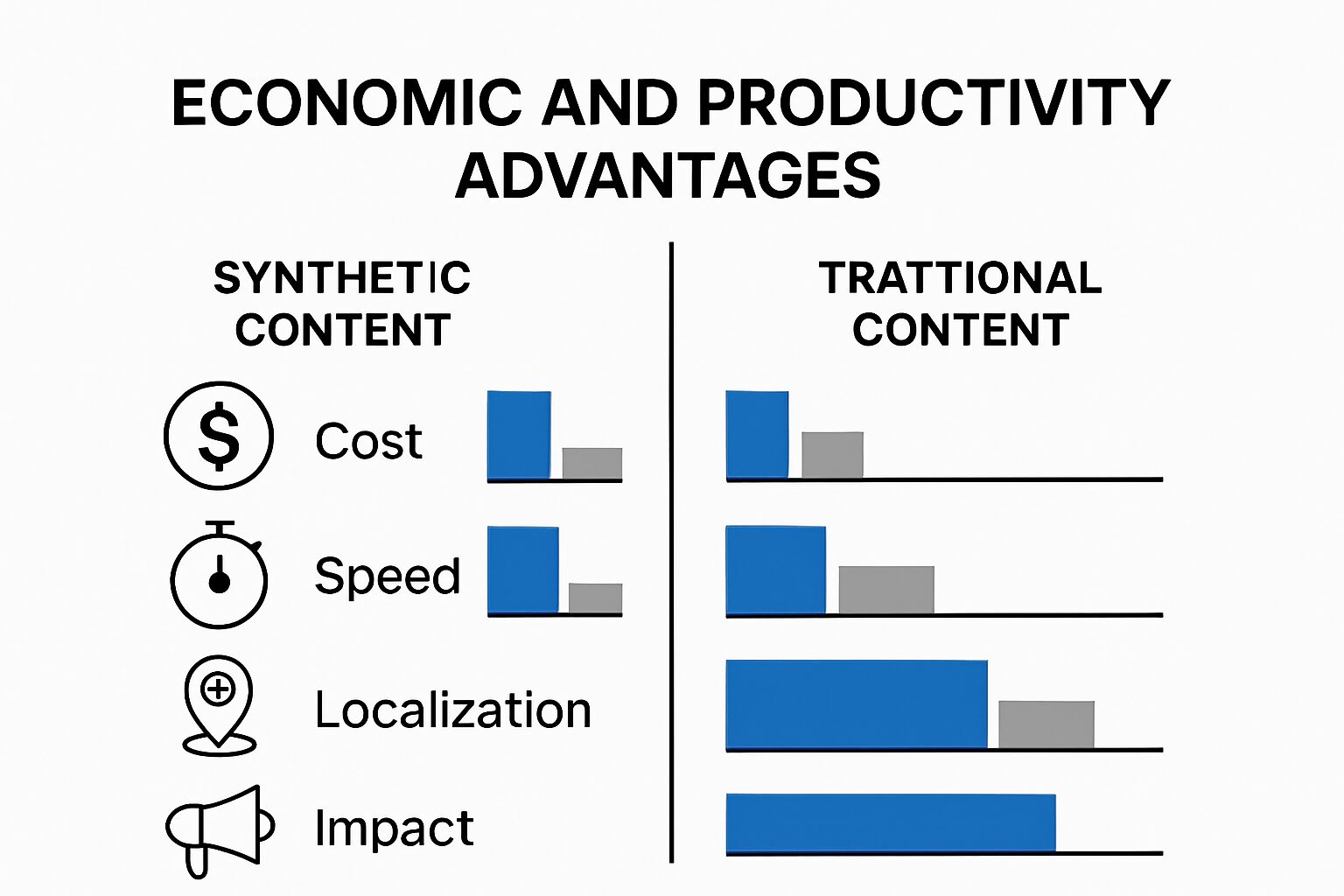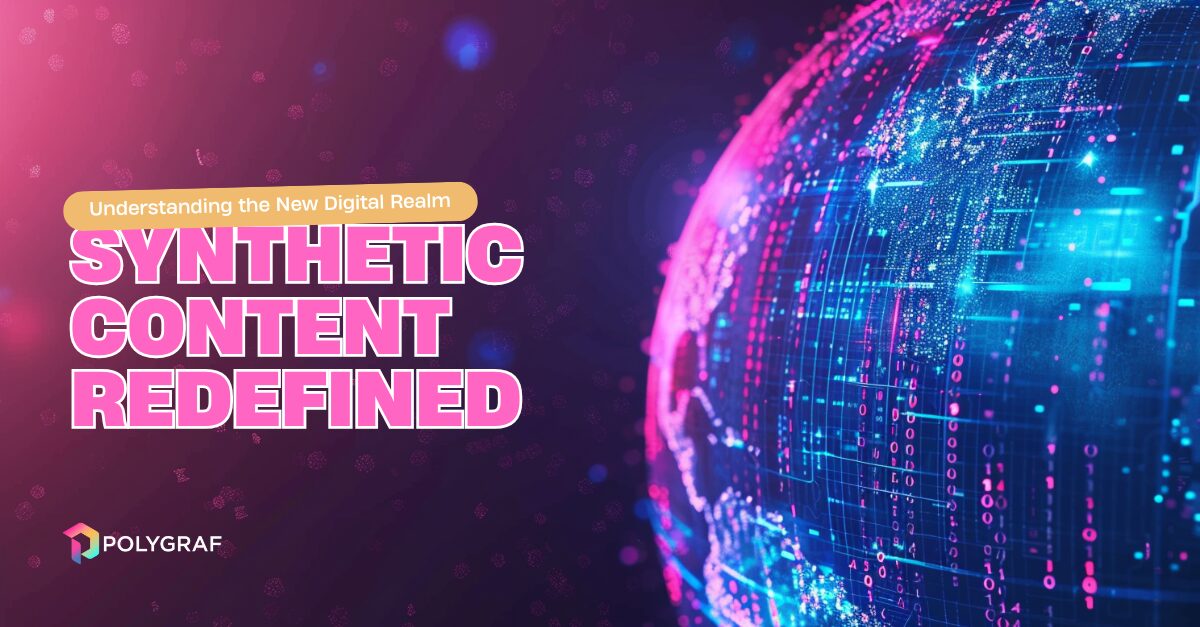Synthetic content is taking over feeds, marketing campaigns and even classrooms, all powered by artificial intelligence. Just last year, over 60% of all digital content produced by major brands contained some synthetic elements. Surprised? Most people still think synthetic content is only about deepfakes or fake news. The real twist is this technology is now supercharging business productivity, slashing production costs and creating content in every format within hours – while raising larger questions about trust and authenticity.

Defining Synthetic Content and Its Types
Synthetic content represents a groundbreaking technological approach to generating media and information through advanced artificial intelligence algorithms. MITRE Corporation defines synthetic content as data or media algorithmically created, encompassing a wide range of digital artifacts that can be entirely new or modified versions of existing material.
The Core Mechanics of Synthetic Content Generation
At its fundamental level, synthetic content emerges from complex AI models that have been trained on extensive datasets. These models learn intricate patterns, structures and traits from existing information to produce novel content that mimic human-created work. IBM Research highlights that synthetic content generation involves sophisticated algorithmic processes using technologies like Generative Adversarial Networks (GANs) and LLMs (Large Language Models). The generation process typically involves several critical stages. First, AI models analyze massive training datasets to understand contextual nuances, linguistic patterns, visual characteristics or audio structures. These models then create new content by predicting and generating elements that align with learned patterns. This approach enables the production of synthetic text, images, audio and video with remarkable precision and Complexity.
Diverse Types of Synthetic Content
Synthetic content manifests across multiple domains, each with unique characteristics and potential applications. The primary categories include: To help readers quickly distinguish the main types of synthetic content discussed, the following table summarizes their characteristics and applications.
| Type of Synthetic Content | Key Characteristics | Main Applications |
| Synthetic Text | AI-generated written content, coherent and contextually appropriate | Articles, reports, creative writing |
| Synthetic Visual Media | Computer-generated images and videos, photorealistic or stylized | Artwork, photographs, deepfakes |
| Synthetic Audio | Artificial speech, music, and sound environments | Voice replication, music, soundscapes |
- Synthetic Text: AI-generated written content ranging from articles and reports to creative writing and technical documentation. These models can produce coherent, contextually appropriate text by understanding language structures and semantic relationships.
- Synthetic Visual Media: Computer-generated images and videos that can be photorealistic or stylized. This includes deepfake technologies, AI-generated artwork and synthetic photographs that appear indistinguishable from real-world imagery.
- Synthetic Audio: Artificially created speech, music and sound. These synthetic audio generations can replicate human voices, compose musical pieces or generate realistic background soundscapes.
Understanding synthetic content requires recognizing its potential for innovation, while maintaining awareness of ethical and legal considerations surrounding its creation and deployment. As AI technologies continue advancing, synthetic content will play an increasingly significant role in various professional and creative domains.
How Synthetic Content Is Created Today
Synthetic content creation has dramatically evolved with advanced artificial intelligence technologies, transforming how digital media is generated. Generative AI research identifies a complex ecosystem of algorithms and models that enable unprecedented content synthesis across multiple domains:
Machine Learning Models and Algorithmic Foundations
Modern synthetic content generation relies on sophisticated machine learning architectures, particularly generative models. Generative Adversarial Networks (GANs) represent a breakthrough technology where two neural networks compete against each other. One network generates content while another evaluates its authenticity, continuously improving the output’s quality and realism. These generative models undergo extensive training using massive datasets, learning intricate patterns and representations. By analyzing thousands or millions of examples, AI systems develop an understanding of structural nuances that allows them to create novel content mimicking human-generated work. The training process involves complex statistical modeling, enabling AI to predict and generate contextually appropriate content across text, images, audio, and video.
Synthetic Content Generation Techniques
Multiple techniques drive synthetic content creation today:
- Transformer Architecture: Large language models like ChatGPT utilize transformer architectures that process sequential data, enabling sophisticated content generation by understanding context and semantic relationships.
- Diffusion Models: Advanced image generation techniques that progressively refine random noise into coherent visual representations, producing highly detailed and realistic synthetic content.
- Neural Style Transfer: Algorithms that can blend content from one with the stylistic characteristics of another, creating unique visual compositions.
PAI (The Partnership on AI) emphasizes the importance of responsible development in synthetic media creation.As these technologies advance, ethical considerations become increasingly critical in managing potential societal impacts and maintaining transparency in synthetic content generation.
Benefits and Challenges for Businesses and Creators
Synthetic content presents a transformative landscape for businesses and creators, offering unprecedented opportunities while simultaneously introducing complex ethical and practical challenges. Unscript AI researchreveals that synthetic media technologies are reshaping content production across multiple industries.
Economic and Productivity Advantages
Businesses are experiencing significant economic benefits from synthetic content generation, which highlights the unprecedented scalability and cost-effectiveness. Today, companies and creators can produce customized content without traditional production constraints, dramatically reducing time and financial investments.
The economic advantages of synthetic content generation for businesses and creators are outlined in the table below for easy reference:
| Advantage | Description |
| Reduced Production
Costs |
Cuts expenses from physical production such as studio rentals, equipment and
talent fees |
| Rapid Content
Generation |
Enables creation of multiple content variations within hours rather than weeks |
| Global Localization | Instantly produces or repurposes content in multiple languages and cultural contexts |

- Reduced Production Costs: Eliminating expenses associated with physical production, such as actor fees, studio rentals, and equipment costs.
- Rapid Content Generation: Creating multiple variations of content within hours instead of weeks.
- Global Localization: Generating content in multiple languages and cultural contexts instantly.
Ethical and Trust Considerations
While synthetic content offers remarkable opportunities, it simultaneously introduces significant challenges. There are growing concerns about potential misuse, particularly regarding misinformation and digital manipulation. Creators and businesses must navigate complex ethical terrain, addressing potential risks such as:
- Misinformation Potential: Synthetic media can be used to create convincing but false narratives.
- Authentication Challenges: Distinguishing between authentic and artificially generated content becomes increasingly difficult.
- Trust Erosion: Widespread synthetic content might undermine audience trust in digital media.
Successful integration of synthetic content requires a balanced approach that prioritizes transparency, ethical guidelines and authenticity. As AI continues evolving, businesses and creators must develop robust frameworks for responsible synthetic content creation.
Future Trends in Synthetic Content
The landscape of synthetic content is rapidly evolving, presenting transformative possibilities and complex challenges across multiple sectors. Research indicates that 2025 marks a critical juncture in understanding and regulating synthetic media technologies.
Emerging Technological Innovations
Advanced AI models are pushing the boundaries of synthetic content generation, creating more nuanced and contextually sophisticated outputs. As an example, synthetic technologies will dramatically reshape educational content, offering personalized learning experiences and enhanced accessibility.
The table below highlights key technological trends shaping synthetic content and their impact, going forward.
| Trend | Description |
| Hyper-Personalization | Tailors content to individual user information and preferences with high precision |
| Cross-Modal Synthesis | Translates content seamlessly between text, audio, video and images |
| Real-Time Generation | Produces high-quality synthetic media instantaneously |
Governance and Ethical Frameworks
As synthetic content becomes more prevalent, robust governance mechanisms are emerging. The need for transparent mechanisms for identifying AI-generated content is critical. Stakeholders are developing comprehensive frameworks to address potential misuse while promoting responsible innovation.
Critical governance considerations include:
- Content Authenticity Markers: Developing standardized labeling systems to help users effortlessly identify synthetic content.
- Consent and Representation Protocols: Creating guidelines for ethical use of synthetic media, particularly regarding personal visual and voice reproduction.
- Algorithmic Accountability: Establishing mechanisms to trace and validate the origins of the synthetic content.
The future of synthetic content represents a delicate balance between technological innovation and ethical responsibility. As AI capabilities continue expanding, businesses, creators, businesses, and policymakers must collaborate to harness these technologies responsibly, ensuring they enhance human creativity rather than replace it.

Protect Your Business from Synthetic Content Risks and Secure Trust
Synthetic content can blur the line between real and artificial information, putting trust and authenticity at risk. As organizations face challenges like AI-generated misinformation, deepfake threats and data leaks, traditional defenses no longer keep up. Organizations concerned about maintaining credibility and compliance in the era of advanced synthetic media need a smarter solution.
Quick Summary
| Takeaway | Explanation |
| Synthetic content utilizes advanced AI technologies | AI algorithms generate digital content like text, images, and audio, transforming media production. |
| Various types include text, visuals, and audio | Synthetic content spans multiple forms, each designed to simulate human-created works in unique ways. |
| Cost-effective for businesses while ensuring rapid generation | Companies can produce customizable content faster and cheaper, enhancing their efficiency and marketing capabilities. |
| Ethical considerations are paramount | As synthetic media grows, tackling misinformation and preserving audience trust are critical challenges for creators. |
| Future trends lean towards personalization and governance | Innovations in AI will prioritize tailored content experiences, along with frameworks for ethical content usage in the future. |
About Polygraf AI:
Polygraf AI provides award-winning AI-native data integrity, monitoring & governance solutions to organizations via an on-prem, Zero Trust framework. As artificial intelligence advances, organizations face new risks from confidential data loss, data breaches, and fake or altered AI-generated content, and the need for optimized content strategies . Polygraf enables data-centric organizations to identify, monitor & and mitigate these emerging threats with its proprietary, agentic AI solutions. The company is headquartered in Austin, TX.
Ready to show customers and investors that your startup leads with credibility and security? Schedule a demo on Polygraf AI and see how you can strengthen your content strategies and compliance edge today.
Frequently Asked Questions
What is synthetic content?
Synthetic content refers to digital media and information that is created algorithmically using advanced artificial intelligence technologies. It encompasses various forms including text, images, audio and video, simulating human-created work.
How is synthetic content generated?
Synthetic content is generated through complex AI models, particularly utilizing techniques like Generative Adversarial Networks (GANs) and Large Language Models (LLMs). These models analyze large datasets to learn patterns and create new, contextually appropriate content.
What are the benefits of synthetic content for businesses?
Synthetic content offers significant advantages such as reduced production costs, rapid content generation and the ability to produce content across multiple languages, enhancing efficiency in marketing and communication strategies.
What ethical considerations should be taken into account with synthetic content?
With the rise of synthetic content, ethical considerations include addressing potential misinformation, challenges in distinguishing authentic from synthetic media, and the risk of eroding audience trust. It’s essential to implement transparency and responsible guidelines in content creation.






